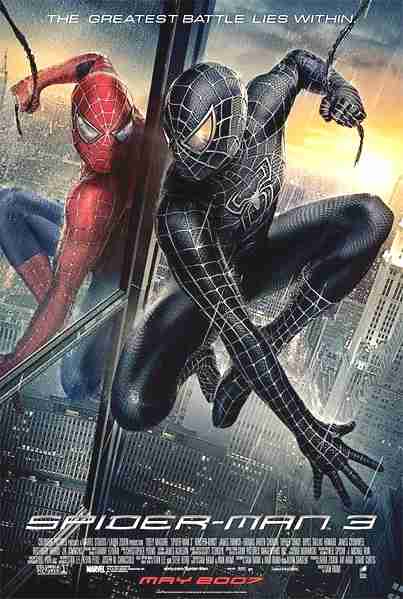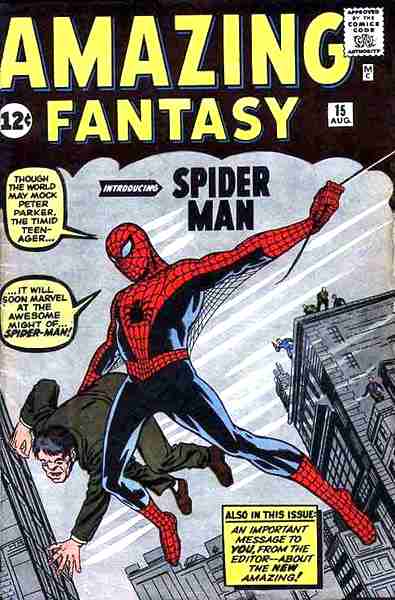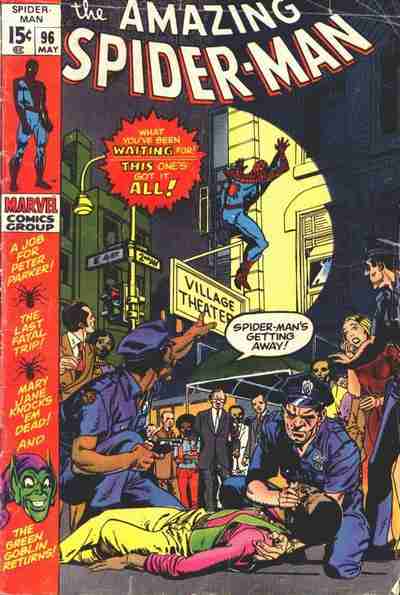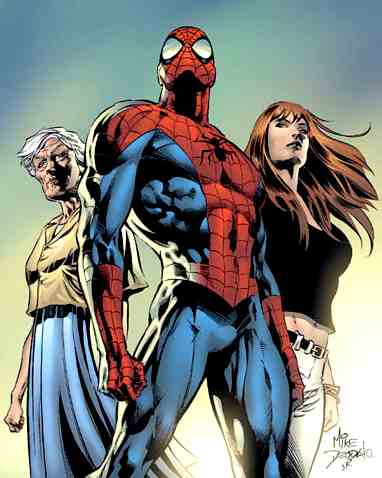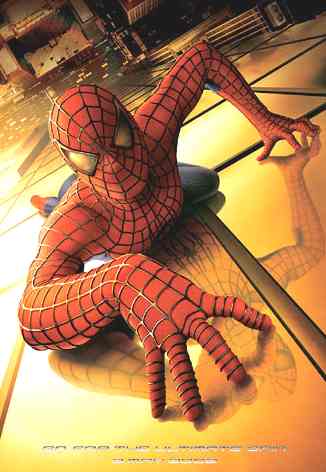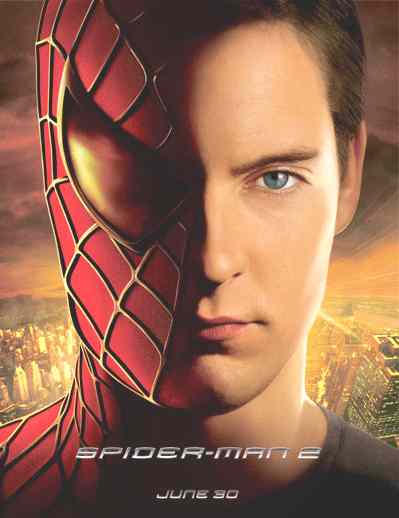|
SPIDER MAN
|
||||||||
|
HOME | BIOLOGY | FILMS | GEOGRAPHY | HISTORY | INDEX | MUSIC | SOLAR BOATS | SPORT | SPONSORS |
||||||||
|
Spider-Man (Peter Benjamin Parker) is a fictional Marvel Comics superhero created by Stan Lee and Steve Ditko. Since his first appearance in Amazing Fantasy #15 (Aug. 1962), he has become one of the world's most popular, enduring and commercially successful superheroes.
When Spider-Man first saw print in the 1960s, teenage characters in superhero comic books were usually sidekicks. The Spider-Man series broke ground by featuring a hero who himself was an adolescent, to whose "self-obsessions with rejection, inadequacy, and loneliness" young readers could relate. Spider-Man has since appeared in various media including several animated and live-action television series, syndicated newspaper comic strips and a successful series of films.
Spider-Man 3 movie poster
Marvel has published several Spider-Man comic book series, the first being The Amazing Spider-Man. Over the years, the Peter Parker character has developed from shy high school student to troubled college student to a married teacher and a member of the superhero team the Avengers, and a scientist in the Spider-girl series.
Publication history
By 1962, with the success of the Fantastic Four and other characters, Marvel editor and head writer Stan Lee was casting about for a new superhero idea. He said that the idea for Spider-Man arose from a surge in teenage demand for comic books, and the desire to create a character with whom teens could identify. In his autobiography, Lee cites the non-superhuman pulp magazine crime fighter The Spider as an influence and both there and in a multitude of print and video interviews said he was inspired by seeing a fly climb up a wall — adding in his autobiography that he has told that story so often he has become unsure of whether or not it is true. Artist Ditko, in a 1990 article by himself, gave a more prosaic origin story for the name:
"In a discussion with me about Spider-Man, Stan said he liked the name Hawkman but DC had the name and character. Marvel would add Ant-Man [and the Wasp] so it would have the insect category. (Technically a spider is not an insect). From that I believed Stan had named the character."
Lee approached Marvel publisher Martin Goodman to seek approval for the character. In a 1986 interview, he described in detail his arguments to overcome Goodman's objections. Goodman agreed to let Lee try out Spider-Man in the upcoming final issue of the canceled science-fiction/supernatural anthology series Amazing Adult Fantasy, which was renamed Amazing Fantasy for that single issue, #15 (Aug. 1962).
Jack Kirby, in a 1982 interview, claimed Lee had minimal involvement in the character's creation, and that it had originated with Kirby and Joe Simon, who in the 1950s had proposed a character called The Silver Spider for the Crestwood comic Black Magic until the publisher went out of business.
Simon, in his 1990 autobiography, disputes Kirby's account, asserting that the supernatural anthology Black Magic was not a factor, and that he (Simon) devised the name "Spiderman" (later changed to "The Silver Spider"), while Kirby outlined the character's story and powers. Simon later elaborated that his and Kirby's character conception became the basis for Simon's Archie Comics superhero The Fly, introduced in early 1959.
Amazing Fantasy #15 (Aug. 1962). Cover art by Jack Kirby (penciller) & Steve Ditko (inker)
Comics historian Greg Theakston says that Lee, after receiving Goodman's approval for the name Spider-Man and the "ordinary teen" concept, approached Kirby. Kirby told Lee about his 1950s Silver Spider/Spiderman, in which an orphaned boy living with an old couple finds a magic ring that gives him superpowers. Lee and Kirby "immediately sat down for a story conference" and Lee afterward directed Kirby to flesh out the character and draw some pages. Steve Ditko would be the inker. "A day or two later", Kirby showed Lee the first six pages, and, as Lee recalled, "I hated the way he was doing it. Not that he did it badly — it just wasn't the character I wanted; it was too heroic". Simon concurs that Kirby had shown the original Spiderman version to Lee, who liked the idea and assigned Kirby to draw sample pages of the new character but disliked the results — in Simon's description, "Captain America with cobwebs".
Lee turned to Ditko, who developed a visual motif Lee found satisfactory, although Lee would later replace Ditko's original cover with one penciled by Kirby. Ditko said,
"The Spider-Man pages Stan showed me were nothing like the (eventually) published character. In fact, the only drawings of Spider-Man were on the splash [i.e., page 1] and at the end [where] Kirby had the guy leaping at you with a web gun... Anyway, the first five pages took place in the home, and the kid finds a ring and turns into Spider-Man."
Ditko also recalled that,
One of the first things I did was to work up a costume. A vital, visual part of the character. I had to know how he looked ... before I did any breakdowns. For example: A clinging power so he wouldn't have hard shoes or boots, a hidden wrist-shooter versus a web gun and holster, etc. ... I wasn't sure Stan would like the idea of covering the character's face but I did it because it hid an obviously boyish face. It would also add mystery to the character....
Much earlier, in a rare contemporaneous account, Ditko described his and Lee's contributions in a mail interview with Gary Martin published in Comic Fan #2 (Summer 1965): "Stan Lee thought the name up. I did costume, web gimmick on wrist & spider signal". Additionally, Ditko shared a Manhattan studio with noted fetish artist Eric Stanton, an art-school classmate who, in a 1988 interview with Theakston, recalled that although his contribution to Spider-Man was "almost nil", he and Ditko had "worked on storyboards together and I added a few ideas. But the whole thing was created by Steve on his own... I think I added the business about the webs coming out of his hands".
Commercial success
A few months after Spider-Man's introduction in Amazing Fantasy #15 (Aug. 1962), publisher Martin Goodman saw the sales figures for that issue and found it had been one of the nascent Marvel's highest-selling comics. A solo series followed, beginning with The Amazing Spider-Man #1 (March 1963). The title eventually became Marvel's top-selling series and the character a cultural icon; a 1965 Esquire poll of college campuses found that college students ranked Spider-Man and fellow Marvel hero The Hulk alongside Bob Dylan and Che Guevara as their favorite revolutionary icons. One interviewee selected Spider-Man because he was "beset by woes, money problems, and the question of existence. In short, he is one of us". Following Ditko's departure after issue #39, John Romita, Sr. became the character's next-most-associated signature artist, penciling the character over the several following years.
An early 1970s Spider-Man story led to the revision of the Comics Code. Previously, it was taboo to depict illegal drugs, even negatively. However, in 1970 the Nixon administration's Department of Health, Education, and Welfare asked Stan Lee to run an anti-drug message in one of Marvel's top-selling titles. Lee chose the top-selling The Amazing Spider-Man; issues #96–98 (May–July 1971) feature a story arc that shows the negative effects of drug abuse. In the story, Peter Parker's friend Harry Osborn starts taking pills and becomes so ill that when Spider-Man fights the Green Goblin (Norman Osborn), Spider-Man defeats Norman by simply showing him his sick son. While the story had a clear anti-drug message, the Comics Code Authority refused to issue its seal of approval. Marvel nevertheless sold the three issues without the Comics Code Authority's approval or seal and sold so well that the industry's self-censorship was undercut.
The Amazing Spider-Man #96 (May 1971), the first of three non-Comics Code issues that prompted the Code's first update, allowing comics to show the negative effects of illegal-drug use. Note cover-blurb reference to "The last fatal trip!" Cover art by Gil Kane
In 1972, a second monthly ongoing series starring Spider-Man began: Marvel Team-Up, in which Spider-Man is paired with other superheroes. In 1976, his second solo series, Peter Parker, The Spectacular Spider-Man began, running parallel to the main series; a third solo series, Web of Spider-Man, launched in 1985, replacing Marvel Team-Up. The launch of a fourth monthly title in 1990, written and drawn by popular artist Todd McFarlane, debuted with multiple variant covers and sold in excess of three million copies, an industry record at the time. There have generally been at least two ongoing Spider-Man series at any time. Several limited series, one-shots and loosely related comics have also been published, and Spider-Man makes frequent cameos and guest appearances in other comic series.
The original Amazing Spider-Man ran through issue #441 (Nov. 1998). Writer-artist John Byrne then revamped the origin of Spider-Man in the 13-issue miniseries Spider-Man: Chapter One (Dec. 1998 - Oct. 1999, with an issue #0 midway through and some months containing two issue), similar to his having details and some revisions to Superman's origin in DC Comics' The Man of Steel. Running concurrently, The Amazing Spider-Man was restarted with vol. 2, #1 (Jan. 1999). With what would have been vol. 2, #59, Marvel reintroduced the original numbering, starting with #500 (Dec. 2003). This flagship series has reached issue #540 as of early 2007.
As of 2007, Spider-Man regularly appears in The Amazing Spider-Man, New Avengers, The Sensational Spider-Man, Friendly Neighborhood Spider-Man, Spider-Man Family and various limited series in mainstream Marvel Comics continuity, as well as in the alternate-universe series The Amazing Spider-Girl, and Ultimate Spider-Man, the alternate-universe tween series Spider-Man Loves Mary Jane, and the alternate-universe children's series Marvel Adventures Spider-Man and Marvel Adventures: The Avengers.
Spider-Man has become Marvel's flagship character, and is often used as the company mascot. When Marvel became the first comic book company to be listed on the New York Stock Exchange in 1991, the Wall Street Journal announced "Spider-man is coming to Wall Street"; the event was in turn promoted with an actor in a Spider-Man costume accompanying Stan Lee to the Stock Exchange. When Marvel wanted to issue a story dealing with the immediate aftermath of the September 11th, 2001 attacks, the company settled on the December 2001 issue of The Amazing Spider-Man. In 2006, Spider-Man garnered major media coverage with the revealing of the character's secret identity, an event detailed in a full-page story in the New York Post before the issue containing the story was even released.
Fictional character biography
In his first appearance, Peter Parker is introduced as a science whiz kid teenager from the Forest Hills section of New York City who gets bitten by a radioactive spider during a science demonstration. He gains powers and at first attempts to become a TV star. He fails to stop a thief, and weeks later the same criminal kills his Uncle Ben. Learning that with great power comes great responsibility, Spider-Man becomes a vigilante. After his uncle's death, he and his aunt become desperate for money, so he gets a job as a photographer at the Daily Bugle selling photos to J. Jonah Jameson, who vilifies his alter ego in the paper. As he battles his enemies for the first time, Parker finds juggling his personal life and costumed adventures difficult, even attempting to give up. Enemies constantly endanger his loved ones, with the Green Goblin managing to kill his girlfriend Gwen Stacy. Though haunted by her death, he eventually marries Mary Jane Watson, and much later reveals his civilian identity to the world, furthering his already numerous problems.
Powers and equipment
A bite from an irradiated spider causes a variety of changes in Peter Parker's body, giving him superpowers. In the original Lee-Ditko stories, Spider-Man has the ability to cling to walls, superhuman strength, a sixth sense ("spider-sense") that alerts him to danger, perfect balance and equilibrium, as well as superhuman speed and agility. In story-lines published in 2005 and 2006, he develops additional spider-like abilities including biological web-shooters, toxic stingers that extend from his forearms, the ability to stick individuals to his back, better control over Spider-sense for detection, and night vision. Spider-Man's strength and speed have also increased beyond his original limits.
Spider-Man's overall metabolic efficiency has been greatly increased, and the composition of his skeleton, inter-connected tissues, and nervous system have all been enhanced. Spider-Man's musculature has been augmented so that he is superhumanly strong and flexible. He has developed a unique fighting style that makes full use of his agility, strength, and equilibrium.
Peter Parker is intellectually gifted, excelling in applied science, chemistry and physics. In fact, Peter's uncanny affinity for science is nothing short of genius. He uses his wits in addition to his powers. Besides outsmarting his foes, he constructs many devices that complement his powers, most notably mechanical web-shooters (ejecting an advanced adhesive compound which dissolves after two hours), which he developed in his teenage years. They are capable of releasing web-fluid in a variety of configurations, including a single strand to swing from, a net, and a simple glob to foul machinery or blind an opponent. He can also weave the web material into simple forms like a shield, a spherical protection or hemi-spherical barrier, a club, or a hang-glider wing. Other equipment includes spider-tracers (spider-shaped adhesive homing beacons keyed to his own spider-sense), a light beacon which can either be used as a flashlight or project a "Spider-Signal" design, a specially modified camera that can take pictures automatically. He has also used an invention of Ben Reilly's (a clone of Peter Parker), called "impact webbing": a pellet that explodes on impact into a wrap-around net of webbing.
Though lacking in directed training, Spider-Man is one of the most experienced superheroes in the Marvel Universe. He has worked with virtually everyone in the superhero community at one time or another. Due to this experience, he has beaten foes with far greater powers and abilities. His fighting style is purely freestyle, which incorporates his speed, agility, strength and spider-sense. A very large part of his combat ability is improvisation and using his wits to out-think his opponents. One constant is his habit of using jokes, puns and insults. This not only causes his adversaries to become angry and distracted, but it also helps Spider-Man deal with any fears or doubts that he might have during a battle.
Spider-Man has had a few costume changes over his history, with three notable costumes -- his traditional red-and-blue costume, the black-and-white alien symbiote (later developed into a regular costume for stealth) and the technologically advanced Stark Armor costume designed by Tony Stark. In early comics and sporadically throughout his run depending on a given artist's interpretation, Spider-Man's costume included webbing that extended from his underarms to his torso.
Spider-Man editor Axel Alonso said in a November 2006 interview that Spider-Man will again wear his black costume beginning February 2007 partially, but not primarily, due to the third Spider-Man film.
Spider-Man, his Aunt May and wife Mary Jane - Art by Mike Deodato
Enemies
Spider-Man has one of the best-known rogues galleries in comics. Spider-Man's most infamous and dangerous enemies are generally considered to be the Green Goblin, Doctor Octopus, and Venom. Others include the Lizard, Chameleon, Hobgoblin, Kraven the Hunter, the Scorpion, the Sandman, the Rhino, Mysterio, Vulture, Electro, Carnage, the Kingpin, and Shocker. As with Spider-Man, the majority of these villains' powers originate with scientific accidents or the misuse of scientific technology, and they tend to have animal-themed costumes or powers. At times these villains have formed groups such as the Sinister Six to oppose Spider-Man.
Supporting characters
Spider-Man was conceived as an ordinary person given great power, and the comics detail his civilian life, friends, family and romances as much as his super-heroic adventures.
Some of the more important and well-known members of his extensive supporting cast include:
Spider-Man the movie
Film
There have been three theatrical films produced starring Spider-Man (played by Tobey Maguire).
Spider-Man
Peter Parker is an orphan, being raised by his genial and loving Uncle Ben (Cliff Robertson) and Aunt May (Rosemary Harris) in the Forrest Hills neighborhood of Queens, New York. He is a shy science whiz high school student who pines after the girl next door, Mary Jane Watson (Kirsten Dunst), whom he has had a crush on since he was six years old according to his aunt. A student working as a photographer for the school paper, apparently Peter's only friend is Harry Osborn (James Franco), whom he tutors and in turn protects him from bullying by the likes of the more popular Flash Thompson (Joe Manganiello).
Before entering a genetics laboratory at Columbia University on a school field trip, he meets Harry Osborn's famous father, Dr. Norman Osborn (Willem Dafoe), wealthy industrialist, CEO of Oscorp, and a brilliant scientist known for his contributions to nanotechnology. Mr. Osborn is impressed with Peter's ability to understand his work while only in high school, and so he reaches out as a father figure to him. While at the exhibit of genetically engineered super spiders and taking photos of M.J. for the school paper, he gets bitten on the hand by one that was loose. He goes home sick. When he awakens the next morning, he finds that his myopia is gone and he has a muscular physique. On the same day, he uses his newfound spider-like reflexes, agility, strength and "spider sense" to avoid being injured by Flash. Soon after, he learns to climb walls due to minute barbs on his body, jump from rooftop to rooftop with ease, and excrete organic webbing from his wrists.
At first, Peter decides to use his powers to impress Mary Jane, by entering a wrestling match in order to use the cash prize to buy a new car. He tells his aunt and uncle he is going to the library rather than a tournament. His uncle confronts him over his strange behavior on the way to what he thinks is the destination and Peter snaps at him. Though Peter wins the match in record time with a makeshift suit and the sobriquet "Spider-Man", the crooked promoter cheats him. An embittered Peter then lets the robber who stole the gate money go, even though he could have stopped him. Tragically, Uncle Ben is shot as the robber carjacks him.
Peter tracks his uncle’s killer and confronts him, but is wracked with guilt for not being a hero sooner. During his time of turmoil, he recalls his uncle’s words, "With great power, comes great responsibility." Peter takes it to heart and vows to use his incredible abilities to fight crime and protect the city as Spider-Man. After graduation, wherein he receives the prestigious science award, Peter attends college and lofts with Harry. However, he is fired from a laboratory position under the supervision of Dr. Connors, and is hired as a freelance photographer by the Daily Bugle as he is the only one with clear pictures of Spider-Man, though he is vilified by the miserly Bugle chief editor J. Jonah Jameson (J.K. Simmons). To make matters worse, Peter finds that Harry is dating M.J. behind his back, which disheartens him. Yet this does not last, and Mary Jane falls in love with both Spider-Man and Peter separately, for each has always been there for her.
Meanwhile, megalomaniacal Dr. Osborn has undergone his own transformation, as he tests his unstable human performance enhancer for the military on himself and goes insane. After he steals the equipment he designed, as the Green Goblin, he targets those who stand in his way and endangers innocent lives, including Aunt May and M.J. in order to attack his enemy's heart once he deduces his identity. He frequently offers him a place at his side, against a city that hates him, to which Spider-Man continuously refuses. Spider-Man must face him, and in the end, the Goblin is killed by his own glider. Norman aks for him to be a son to him, but Peter states that his father was Ben Parker. His last request is "Don't tell Harry." Harry, in turn, swears vengeance on Spider-Man, who he believes killed his father after seeing Spider-Man bring his corpse to the Osborn mansion, and strengthens his friendship with Peter at the funeral. After this, Peter turns away from M.J., realizing his duty to protect those he loves from his enemies.
Spider-Man 2 - Tobey Maguire as Peter Parker
Spider-Man 2
Two years have passed since the mild-mannered Peter walked away from his longtime love Mary Jane Watson. He struggles with "the gift and the curse" of his powers while attempting to balance his duties as an elusive superhero and Columbia University physics student in Dr. Connors’ (Dylan Baker) quantum mechanics class. He loses a job as a pizza delivery boy, is nearly fired for not providing a photo of his alter ego to Jameson, and is under financial stress. Even Aunt May is threatened with foreclosure. Moreover, his relationships are unraveling: he is losing M.J. and Harry’s vendetta against Spider-Man is growing, as he even show signs of resentment toward Peter for his loyalty to the costumed vigilante. With all the strain, his powers falter.
Having chosen the road to responsibility, he finds it most difficult to let go of M.J. In the meantime, M.J. has moved on in her life, embarking on an acting career and is to be married to the astronaut son of his boss, John Jameson (Daniel Gillies). Peter fails to see the play in which Mary Jane stars in, angering her, but later he tries to reconnect with her. In a moment of selfishness, Peter shirks his responsibilities as Spider-Man. But his life becomes complicated once more as Peter’s idol, the brilliant nuclear physicist Dr. Otto Octavius (Alfred Molina), is reincarnated in an experimental accident as a diabolical madman and multi-tentacled menace who he must stop in his octagonal tracks before he blows up the city in rebuilding his fusion power experiment.
After Peter and Aunt May visit Uncle Ben's grave, Peter confesses how his inaction resulted in his uncle's death, with his aunt considerably shaken by this, but soon sees his bravery in admitting the truth. After a change in heart about Spider-Man due to his rescue of her, Aunt May makes Peter realize the hope Spider-Man gives to the people of New York and that sometimes one must let go of their dreams for the good of mankind. Elsewhere, Otto Octavius, dubbed Doctor Octopus by the media, makes a deal with Harry, head of Oscorp’s special projects, to supply him with the tritium necessary to fuel his project; he has to bring Spider-Man to Harry alive. "Doc Ock" kidnaps Mary Jane and sets a train off course in a ploy to trap the reinvigorated Spider-Man, which is successful. As Harry is about to stab Spider-Man after the exchange, he unmasks him and is shocked to find his best friend is also his arch-nemesis. Peter awakens from unconsciousness and pleads with Harry to tell him where Octavius is, so he can save M.J., to which Harry complies. He engages Doc Ock in a short skirmish. After reproaching Octavius with his aunt’s words of wisdom and revealing himself as the "brilliant but lazy" student he met before, the good-natured persona of the doctor resurfaces intent on destroying his machine. In the midst of this, M.J. sees that Peter is Spider-Man, but he tells her they can never be together because of his enemies.
In the end, Harry is urged by the hallucination of his father to avenge him and he stumbles upon the Green Goblin equipment. Mary Jane leaves John Jameson at the altar to be with Peter, who is emotionally drained and accepts her offer of love.
Spider-Man 3
Peter has struck a balance between his duties and basks in the spotlight with his personal success. As Peter Parker, he is at the top of Dr. Connors’ quantum mechanics class and has the girl of his dreams that he hopes to propose to, while the city is starting to embrace Spider-Man for the first time in his career. However, a storm is brewing on the horizon.
As the New Goblin, Harry attacks him, but suffers amnesia after a hard blow to the head. While he rejoices with his friend back, Peter learns that the man he had thought killed his uncle was only an accomplice, while the true killer is still at large. The criminal is Flint Marko (Thomas Haden Church), who after an escape from prison accidentally comes upon a particle physics test facility, wherein he undergoes a transformation into the monstrous Sandman. Around this time, an alien symbiote attaches itself to Peter, changing his suit to black and brings out a dark, vengeful side of his personality that he struggles to control. Peter becomes overconfident and neglectful of those he loves, and must choose between the seductive new power and the compassionate hero he used to be. M.J. becomes distant after poor reviews of her singing performance and being pushed away. Also, Mary Jane grows jealous of Peter’s classmate Gwen Stacy (Bryce Dallas Howard), whom Spider-Man saves and shares a kiss with in the same manner he had done with Mary Jane in the first film. Harry remembers his objective after hallucinating an image of his father once more and briefly kissing Mary Jane, and forces M.J. to break up with Peter to attack his heart as his father had done. In a desperate struggle between the former friends at the Osborn mansion, Harry is horribly scarred by his own pumpkin bomb. Peter even has a rival in the cocky photographer Eddie Brock, Jr. (Topher Grace), whom he humiliated and believes Peter stole his girlfriend Gwen. Peter uses Gwen to hurt Mary Jane, but sees the error in his ways when he pushes M.J. down.
Aunt May says Uncle Ben wouldn’t want vengeance in their hearts and believes he can set things right, and Peter realizes he is not ready for marriage since he can‘t put M.J. first. As Brock prays for Parker’s death in a church, he inspects Peter’s yells he hears as Peter fights his inner demons to remove the suit, which falls upon the unsuspecting onlooker. Venom is born and teams up with the Sandman to put an end to Spider-Man, by luring him with Mary Jane. Peter asks Harry to swallow his pride and the help to save her, but he refuses until the caring Osborn butler tells him the truth of his father’s death, as he saw the wounds came from the glider. In the final battle, the two villains are defeated and Harry dies in the arms of those he cares about as a hero. Peter is able to find forgiveness over his uncle’s apparently accidental death as described by Marko and reconciles with Mary Jane after attending his best friend’s funeral.
The Amazing Spider-Man comic hero Peter Parker
LINKS and REFERENCE
A - Z FILMS INDEX
A - Z ACTORS INDEX
Amazing tastes for super heroes
Solar Red | Solar Crush + | Solar Cola | Solar Citrus + | Solar + - the healthier alternatives
|
||||||||
|
This
website
is Copyright © 1999 & 2007 NJK.
The bird |
||||||||
|
AUTOMOTIVE | BLUEBIRD | ELECTRIC CARS | ELECTRIC CYCLES | SOLAR CARS |
